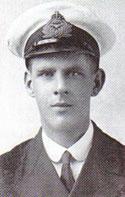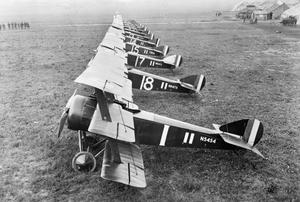Richard Minifie facts for kids
Quick facts for kids
Richard Pearman Minifie
|
|
|---|---|

Richard Minifie
|
|
| Born | 2 February 1898 Alphington, Victoria |
| Died | 31 March 1969 (aged 71) Malvern, Victoria |
| Allegiance | United Kingdom Australia |
| Service/ |
Royal Naval Air Service Royal Australian Air Force |
| Years of service | 1916–19 c. 1941–45 |
| Rank | Squadron Leader |
| Unit | No. 1 (Naval) Squadron RNAS |
| Battles/wars | First World War Second World War |
| Awards | Distinguished Service Cross & Two Bars |
| Other work | Managing Director of James Minifie & Co. Pty Ltd (1949–66) President of the Federal Council of Flour Millowners of Australia (1949–66) |
Richard Pearman Minifie (born February 2, 1898 – died March 31, 1969) was a brave Australian fighter pilot. He was known as a "flying ace" during the First World War. A flying ace is a pilot who shoots down five or more enemy aircraft.
Richard was born in Victoria, Australia. He went to Melbourne Church of England Grammar School. In June 1916, he traveled to the United Kingdom and joined the Royal Naval Air Service. He trained to be a pilot and finished his training in December.
In January 1917, Richard joined No. 1 (Naval) Squadron RNAS on the Western Front. He flew Sopwith Triplanes. During that year, he shot down seventeen enemy planes. This made him the youngest Australian flying ace of the First World War. He was also the top-scoring ace on the Triplane in his squadron.
Later in 1917, his unit started using Sopwith Camel planes. Richard shot down four more enemy aircraft with this new plane. This brought his total victories to twenty-one planes. In March 1918, Richard crash-landed in German territory. He spent the rest of the war as a prisoner of war in Germany. After the war, he returned to Australia. He worked in his father's flour milling business. During the Second World War, he served as a squadron leader in the Royal Australian Air Force. Richard Minifie passed away in 1969 when he was seventy-one years old.
Early Life and Education
Richard Pearman Minifie was born in Alphington, Victoria, Australia. His birthday was February 2, 1898. His father, James Minifie, was a flour miller from England. His mother was Beatrice Kate.
When he was young, Richard went to Melbourne Church of England Grammar School. He was a prefect in 1915, which means he was a student leader. He also became a lieutenant in the school's Cadet unit. After finishing school, Richard won a scholarship. This allowed him to study at Trinity College at the University of Melbourne.
First World War Service
In 1916, Richard Minifie lived in Elsternwick, Victoria. He decided to put his studies on hold. He traveled to the United Kingdom to join the war effort. On June 11, he joined the Royal Naval Air Service in Crystal Palace, London.
He was accepted for flight training as a probationary flight sub-lieutenant. For six months, he trained at different naval bases. These included Eastbourne, Cranwell, East Fortune, and Dover. He earned his pilot's "wings" during this time. In October, he became a flight sub-lieutenant. Early in 1917, he was sent to France. He joined No. 1 (Naval) Squadron. There, he flew Sopwith Triplanes, which were planes with three sets of wings. He became very successful with this type of aircraft.
Early Victories and Awards
In February and March 1917, No. 1 Squadron was constantly fighting. They were active along the Somme area of the Western Front. In April, the squadron was very busy during the Arras offensive.
On April 29, Richard Minifie achieved his first two aerial victories. He shot down an Albatros D.III by himself. Then, he helped shoot down a second plane with another Australian pilot, Flight Sub-Lieutenant Robert A. Little. Over the next two months, Richard took part in important ground attacks. These attacks happened at Bullecourt and during the Battle of Messines. He also kept adding to his number of enemy planes shot down. During this time, he officially became a flying ace. At just 19 years old, Richard Minifie was the youngest Australian ace of the First World War.
He was promoted to acting flight lieutenant in July. Later that month, he joined the Passchendaele offensive. On August 8, Richard destroyed a German scout plane. The plane crashed in flames, marking his seventh victory. Ten days later, he attacked two German airfields. He flew very low, at about 400 feet (120 meters). He fired about 450 rounds of ammunition into the hangars.
Richard was recognized for shooting down several German aircraft. He was also praised for his attacks on ground targets between April and September. Because of his bravery, he received the Distinguished Service Cross. This award was officially announced on November 2, 1917.
Between August and October 1917, Richard Minifie shot down eleven more German planes. This brought his total to seventeen victories. All these victories were achieved while flying the Sopwith Triplane. This made him No. 1 Squadron's highest-scoring ace on that aircraft. He even surpassed his commanding officer and friend, Lieutenant Commander Roderic Dallas, by one victory.
In late October, the squadron returned to the United Kingdom. They were getting new planes, the Sopwith Camel. On November 30, it was announced that Richard had received a Bar to his Distinguished Service Cross. This was for his "conspicuous gallantry in air fighting throughout October." This means he showed great bravery in air battles.
Final Victories and Capture
When he returned to the Western Front, Richard Minifie achieved four more aerial victories. He scored these while flying the Sopwith Camel. In March 1918, he was promoted to acting flight commander. Later that month, he temporarily led No. 1 Squadron.
On March 13, Richard led a group of four planes on a patrol. They met five German scout planes in the air. In the fight, Richard personally destroyed two of the enemy planes. A third was shot down by one of his pilots. These two scout planes were Richard's last victories of the war. This brought his final score to twenty-one enemy aircraft shot down. He became the seventh highest-scoring Australian ace of the war. His victories included ten planes destroyed, one shared destroyed, eight out of control, one shared out of control, and one captured.
For his bravery, especially in the air battle on March 13, Richard Minifie received a second Bar to his Distinguished Service Cross. This award was announced on April 17, 1918. The announcement praised his "courage and daring in the face of the enemy."
On March 17, 1918, Richard Minifie took off in his Camel for a mission. During the flight, he was forced to crash-land in German territory. This happened near Houthulst Forest, Belgium. It's not clear why he had to land. It might have been because he was shot down in a fight or his engine failed. He was captured by German forces and became a prisoner of war. He spent the rest of the war in prison camps in Germany.
Roderic Dallas, his commanding officer, wrote to Richard's mother. He told her that Richard was a prisoner of war. He described Richard as "a brilliant pilot and air fighter." He also said that Richard's victories were won by "clean, clever fighting." He added that Richard was always modest about his great achievements.
On April 1, the Royal Naval Air Service and the Royal Flying Corps joined together. They formed the new Royal Air Force. Richard was promoted to captain on the same day. He was released from captivity after the war ended in November 1918. He returned to the United Kingdom in December 1918. Richard came back to Australia in May 1919.
Life After the War
Back in Australia, Richard Minifie started studying again. He used his scholarship to study mathematics and science at the University of Melbourne. However, he soon left the course. He decided to join his father's flour milling business instead. The company was called James Minifie & Co. Pty Ltd.
On October 19, 1921, Richard married Nellie Frances Roberts. Their wedding was at the Holy Trinity Church in Kew. They had four children together. Richard's father passed away the next year. Richard, his brother James, and his father's business partner, James Gatehouse, continued to run the business. Over the next thirty years, they worked hard. They successfully grew the company a lot.
On June 17, 1941, Richard Minifie joined the Royal Australian Air Force for the Second World War. He became an officer in the Air Training Corps. On August 23, he was promoted to flying officer. He also became an acting squadron leader. He was put in charge of No. 1 Squadron of No. 1 Cadet Wing.
After the war, he returned to the flour milling business. In 1948, he became president of the Victorian Flour Millers' Association. The next year, Richard was made managing director of James Minifie & Co. Pty Ltd. He also became president of the Federal Council of Flour Millowners of Australia. He retired from these roles in 1966. Richard Minifie passed away on March 31, 1969. He was cremated. His wife, son, and three daughters survived him.
Images for kids




